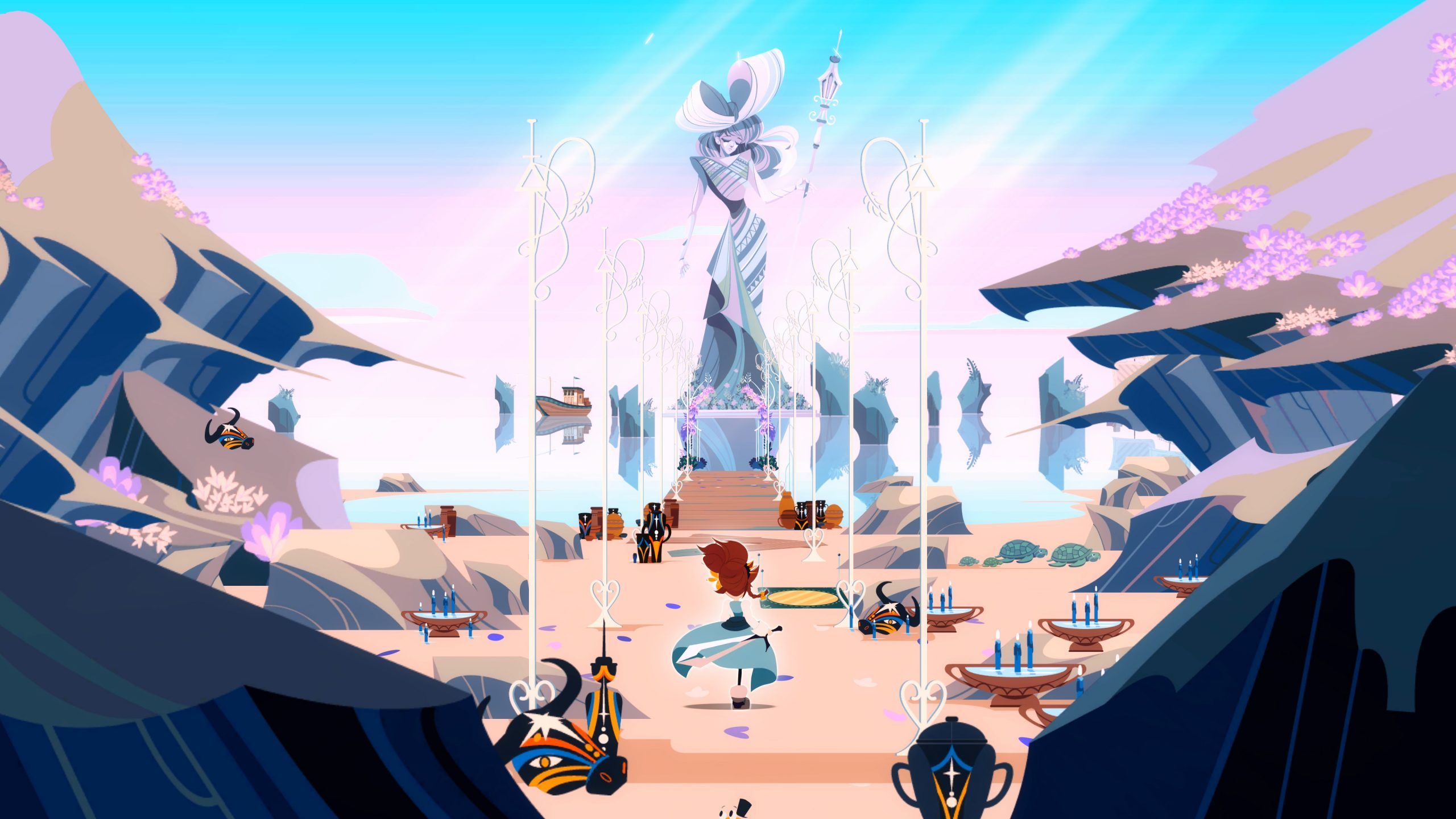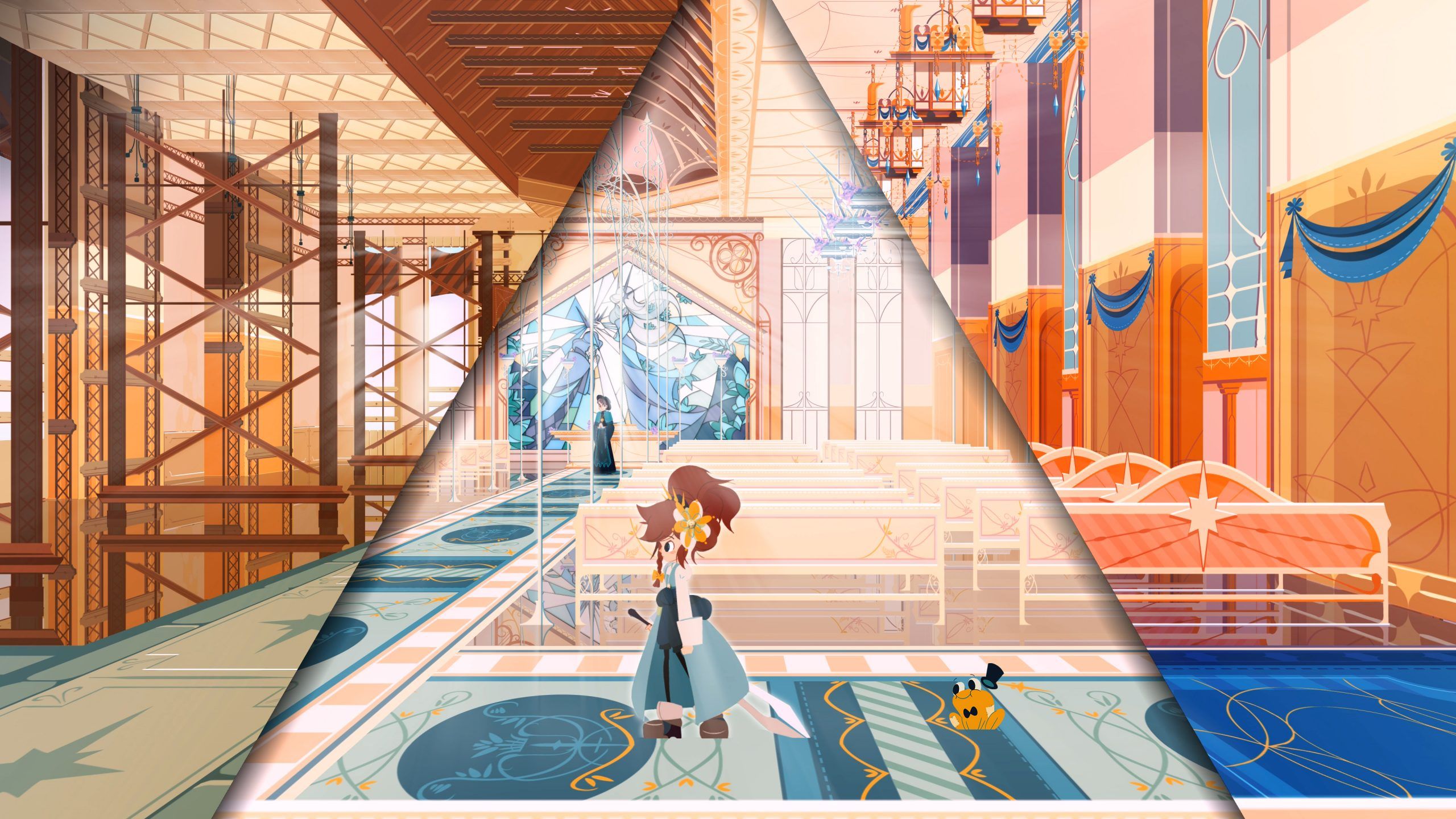Cris Tales is a game of what is, was, and could be.
The time-bending turn-based RPG, developed by the Colombia-based Dreams Uncorporated and SYCK, under indie publisher Modus Games, wears its JRPG and cultural inspirations on its sleeve while bringing on a unique hook of keeping its world’s past, present, and potential future always in view.
Announced at E3 2019, the title became one of our sleeper hits from the show. And now, a year later, DualShockers and other outlets were invited (digitally) to take another look at the game that delved deeper into its combat, characters, and the vibrant, hand-drawn world of Crystallis.
Taking control of protagonist Crisbell, with her top-hat wearing frog companion Matias and party members Cristopher and Willhelm in tow, the walkthrough began with the group venturing out from the starting area - and Crisbell’s hometown - of Narim and into the wilderness toward the city of St. Clarity.
The wilderness itself functions as its own dungeon, with monsters and beasts ready to attack at any moment via random encounters much like what’s seen in any 90s-era JRPG. And it’s here where you can really get a feel for the game’s combat and see all the potential creativity that can open up in battle through Cris Tales’ approach to time manipulation.
For example, take the party’s first battle in the walkthrough against a group of goblins. In every encounter, the turn order is displayed at the top of the screen through a series of character portraits, letting you know who’s up and who’s on deck to allow you to plan accordingly. Your active party member stands in the center of the fight while enemies take position either on the left or right of the terrain.
Up first in this scenario was Willhelm, a time mage just like Crisbell, but of a different type and skillset. His area of expertise lies in plant magic, which was used to cast a poison plant on one of the goblins. As is the turn-based RPG standard, poison deals damage every turn for as long as the status remains in effect. Crisbell, however, can draw those effects out.
By invoking what are called Future or Past Crystals, Crisbell can throw enemies forward or backward in time. The poisoned goblin on the right, in this case, was sent into the future, now appearing as an older, broken down version of the imposing, armored enemy that was just there a second ago, with the poison having taken its toll on him for who knows how long.
The two goblins on the party’s left, meanwhile, had a different surprise awaiting them, getting sent back to the past by Crisbell to a point where the enemies were not only younger, but smaller. Willhem stepped back in to plant a poison seed at their feet, which grew and detonated on them once Crisbell’s turn came around again to bring them back to the present day.
That same strategy won’t work on every enemy, though. In a later battle against a pack of wolves, Crisbell sending them into the future actually gave them time to grow and get stronger, making them much more difficult to deal with.
The effects of time travel vary across different enemy types and even bosses, with each carrying a different set of strengths and weaknesses across their past, present, and future forms. It’ll be on you to learn how to use Crisbell’s powers to your advantage, which can be aided by a scan ability Willhelm can learn and improve over time.
Combat also carries a timing element similar to that of the Paper Mario series, where a properly timed button press on an attack can lead to a critical hit, and likewise for defense and counters.
After emerging out of the wilderness, we were shown a brief glimpse of the world map, with St. Clarity a short walk away. The map itself is the JRPG standard, with players being able to unlock vehicles later on to traverse it faster or reach otherwise inaccessible areas.
Upon arriving at St. Clarity, it’s apparent that it’s a city divided. At the top is the “Walled City,” a lavish and thriving part of town where the city’s nobles reside, and down below is the “Flood Light District,” the slums where the city’s sewage often washes through.
St. Clarity isn’t a city created entirely out of fantasy either. With the Dreams Uncorporated developers all being natives of Colombia, the team wanted the game to have their voices and experiences from growing up in the country be just as much a part of the game as its JRPG roots.
As Modus Games producer Derek Neal explained, almost everything in Cris Tales is based on Colombian stories, heritage, and culture.
So St. Clarity, for instance, is based on the real-life city of Cartagena, which also has a similar social and economic divide.
“We created a term that we call ‘endemic fantasy’,” said Jeff Cardenas, a dev producer at Dreams Uncorporated. “It’s basically to strike the magic of all the things in our country….our architecture, our animals, our floral.”
The game is a love letter to JRPGs, but also to Colombian culture and stories, Cardenas added.
With the game’s display of time (in non-combat situations) - the screen is divided into three parts, the past on the left, the present in the middle, and projected future on the right - you can see what the city was long before Crisbell and co. arrived, and where it’s going based on its current trajectory. That applies to the city’s people too, who each have a younger version of themselves in the past and an older version in the future that can potentially be altered.
The future and what you see of it is what will be in your control. By interacting with the city’s people, completing side quests, and making decisions as the story progresses, the party can reshape the future of St. Clarity to change certain characters’ fate, and hopefully shift the direction of the city toward a more even and prosperous social and economic playing field.
During the walkthrough, we saw a couple particular examples of the impact the party can have on the city and other areas they’ll visit later in the full game. Each completed side quest didn’t change much in the present day at the center of the screen, but the future on the right changed to gradually show a cleaner, upstarted Flood Light District.
The past and future aren’t just a show of progress either. They can be an active part of the puzzle, too. Some scenarios we were shown, for instance, are solved by sending Matias forward or backward in time to grab an item that didn’t exist in the present, eavesdrop on old conversations or ones that have yet to happen to gain insight, or having him plant seeds in the past for use when it’s time later on.
The walkthrough was still only a small portion of the final product, but carries a lot of promise and intrigue, just like with what was shown a year ago.
Cris Tales isn’t a game that shies away from its inspirations, Final Fantasy IV, VI, and Chrono Trigger were mentioned a lot during the demo. But its unique approach to time, and the dev team’s pull from their own heritage and personal experiences go far in making it stand out on its own.
Cris Tales was announced to launch November 17 during the PC Gaming Show this past weekend. It will be available on the PlayStation 4, Xbox One, Nintendo Switch, PC, and Google Stadia, and has a next-gen PlayStation 5 and Xbox Series X release in the works. There’s also a demo that’s up for download now on Steam and GOG that was recently updated to include Willhelm as a party member, along with an eight-battle mini Colosseum that is a small taste of an expanded mode that will be included in the full game.



